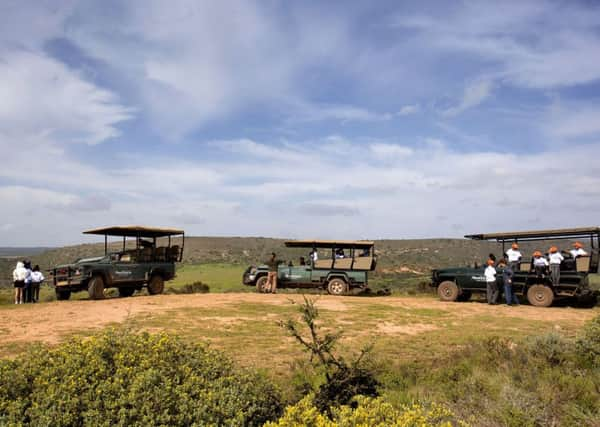Travel review: South Africa - wide-eyed at wildlife


I’ve joined a group of 11-year-old pupils from Grahamstown Primary School for a Bush Day in the Amakhala Game Reserve on South Africa’s Eastern Cape, as part of a six-week Coaching for Conservation educational (C4C) programme.
Originally set up by anthropologist Lesley McNutt as a Botswana-based project in 2004, C4C aims to teach children about endangered species and their environment through interactive games and sport. So far, the project has been a huge success, counting Prince William and Prince Harry as supporters, and there are now plans to implement it in other regions of Africa.
Advertisement
Hide AdAdvertisement
Hide AdIn 2013, C4C was invited to join with Investec’s Rhino Lifeline project in South Africa, tweaking the curriculum to focus on the highly endangered African rhino. As we bump across the reserve’s muddy terrain, several warthogs scurry into the bushes, their tails held erect like radio antennae, causing roars of laughter all round.
When coach and game ranger Melumzi stops the vehicle to pick up a dry ball of elephant dung, smiles quickly turn into wrinkled grimaces.
Along with providing entertainment, Melumzi also has some important lessons to share. He tells the children, who are now listening intently, that on average, three black rhinos are poached in South Africa every day; then goes on to say their prized horns are made of nothing more than calcium and keratin – just like our fingernails.
While the children gaze at two of Amakhala’s white rhinos, Melumzi explains how the animal can quickly divert its course, a skill that can be employed both on the football pitch and in everyday life. “If your friends do something you think is wrong, then it’s important to change direction and turn away.”
Advertisement
Hide AdAdvertisement
Hide AdBack at the camp base, which consists of a classroom and sports area, the message is consolidated through games and lessons guided by project co-ordinators Jenny Gush and Kate Muir.
Some children perform a haka-style dance with sticks representing rhino horns, while chanting C4C’s core values: respect yourself; respect each other; respect your environment.
Meanwhile, another small group gathers in a circle, each person representing a different animal or part of the landscape and linked together with pieces of string to form giant cat’s cradle. I join in as a rhino.
“What happens if we lose rhino?” asks Kate, giving me a cue to release my string. “And then water?”
Another child lets go, causing the entire web to collapse.
Advertisement
Hide AdAdvertisement
Hide AdSince Lesley and John started C4C, more than 9,000 children have benefited from the programme in both Botswana and South Africa, through courses or day visits to schools. Data shows that not only are they better players on the football field, but they also have improved knowledge of wildlife and, most importantly, they greater value the animals and wild spaces in which they live.
The decision to target 11-year-olds isn’t a happy accident; anthropological studies suggest that age group has the right balance of cognitive understanding and a willingness to learn. “Their minds are like sponges,” says Jenny, who belongs to one of the farming families responsible for setting up Amakhala in 1999. “They soak up everything.”
Jenny, who runs Woodbury Lodge, recognises the important relationship between tourism, conservation and education. The future of wildlife – and subsequently the success of safaris – in Africa will be shaped by the next generation; in turn, more visitors to the continent can give communities an essential financial boost.
While most visitors to Amakhala will not be aware of the C4C project, one per cent of the money they pay for a bed goes to the Amakhala Foundation. Additional financial support is supplied by charitable foundation Tusk, which celebrates its 25th anniversary this year.
Advertisement
Hide AdAdvertisement
Hide AdTo mark the occasion, British fashion designer Penelope Chilvers has designed a safari backpack featuring embroidered patches adapted from drawings by schoolchildren on the C4C project. A percentage of the £249 bag will be donated to Tusk, and the individual patches will also be available for sale (from £6).
Chilvers, whose parents have a home in Hermanus, on the Western Cape, draws inspiration from Africa for her collections and was keen to contribute to conservation, in particular education.
“It’s the most exciting continent in the world,” she tells me when we meet at her boutique in Mayfair, London, where shelves are lined with suede desert boots and sturdy leather bags that could easily slip onto a safari packing list.
“As a child, I was lucky enough to go on safari – I’ll never forget that experience – and ‘Take me to Africa’ [her own personal motto] has always been my dream.”
Advertisement
Hide AdAdvertisement
Hide AdThe schoolchildren from Grahamstown could never have imagined their artwork would end up adorning a piece of designer apparel, for which there’s already a waiting list. But then again, few probably thought they’d ever see a rhino in the wild.
Sometimes, though, far-flung dreams can become a very attainable reality.